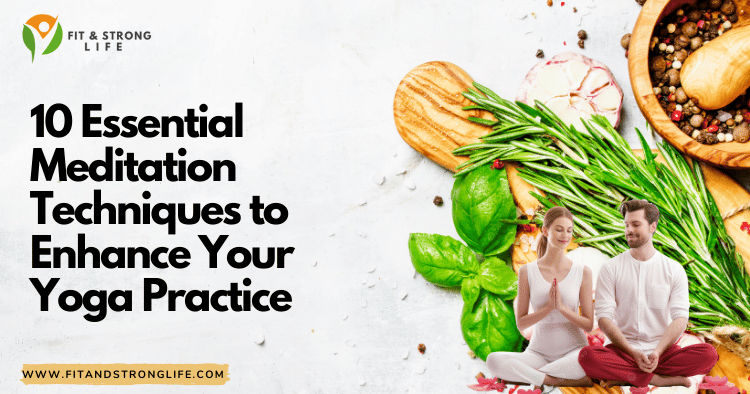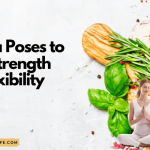Table of Contents
- Introduction
- Mindfulness Meditation
- Breath Awareness
- Loving-Kindness Meditation
- Body Scan Meditation
- Guided Visualization
- Chakra Meditation
- Mantra Meditation
- Zazen (Seated) Meditation
- Walking Meditation
- Conclusion
Introduction
Yoga and meditation are two powerful practices that complement each other beautifully. While yoga focuses on physical postures and movements, meditation dives deeper into the mind, helping to cultivate awareness, peace, and emotional balance. Integrating meditation into your yoga practice can elevate your experience and enhance the benefits of both disciplines. In this article, we’ll explore 10 essential meditation techniques that can enrich your yoga journey, making it more holistic and fulfilling.
Mindfulness Meditation
Mindfulness meditation involves paying attention to the present moment without judgment. By focusing on your breath or bodily sensations, you can develop a deeper awareness of your thoughts and feelings.
Benefits:
- Reduces stress and anxiety
- Improves emotional regulation
- Enhances focus and concentration
How to Practice:
- Find a comfortable seated position.
- Close your eyes and take deep breaths.
- Focus on your breath, noting each inhalation and exhalation.
- If your mind wanders, gently guide it back to your breath.
“Mindfulness is the miracle by which we master and restore ourselves.” — Thich Nhat Hanh
FAQ:
Q: How long should I practice mindfulness meditation?
A: Start with 5-10 minutes daily and gradually increase as you become more comfortable.
Breath Awareness
Breath awareness is a simple yet powerful technique that helps you connect your mind and body. It can be particularly beneficial during yoga sessions.
Benefits:
- Promotes relaxation
- Enhances lung capacity
- Increases energy levels
How to Practice:
- Sit or lie down comfortably.
- Inhale deeply through your nose, filling your lungs.
- Hold for a moment, then exhale slowly through your mouth.
- Repeat this for several minutes, focusing solely on your breath.
“The breath is the bridge which connects life to consciousness, which unites your body to your thoughts.” — Thich Nhat Hanh
Loving-Kindness Meditation
Loving-kindness meditation, or Metta, encourages you to cultivate compassion and love towards yourself and others.
Benefits:
- Increases feelings of empathy
- Reduces negative emotions
- Fosters emotional intelligence
How to Practice:
- Sit comfortably, close your eyes, and take a few deep breaths.
- Silently repeat phrases like, “May I be happy. May I be healthy.”
- Gradually expand your focus to loved ones, acquaintances, and eventually all beings.
“Love and compassion are necessities, not luxuries. Without them, humanity cannot survive.” — Dalai Lama
Body Scan Meditation
This technique promotes awareness of different body parts, helping you release tension and connect with your physical self.
Benefits:
- Enhances body awareness
- Reduces physical pain
- Promotes relaxation
How to Practice:
- Lie down comfortably and close your eyes.
- Start with your toes, consciously relaxing each part of your body.
- Move up to your head, noticing any tension and letting it go.
Table: Body Scan Steps
| Step | Action |
|---|---|
| 1 | Focus on toes |
| 2 | Relax feet |
| 3 | Move to legs |
| 4 | Relax hips |
| 5 | Continue to head |
“The body is your temple. Keep it pure and clean for the soul to reside in.” — B.K.S. Iyengar
Guided Visualization
Guided visualization involves imagining a peaceful scene or situation, often led by a teacher or audio guide.
Benefits:
- Enhances creativity
- Reduces stress
- Improves mental clarity
How to Practice:
- Find a quiet space and close your eyes.
- Listen to a guided meditation or visualize a serene environment.
- Engage all your senses to make the visualization vivid.
FAQ:
Q: Can I do guided visualization on my own?
A: Absolutely! Use your imagination or find recordings online.
“Visualization is daydreaming with a purpose.” — Bo Bennett
Chakra Meditation
Chakra meditation focuses on the body’s energy centers, promoting balance and healing.
Benefits:
- Enhances spiritual growth
- Improves emotional health
- Increases self-awareness
How to Practice:
- Sit comfortably and close your eyes.
- Visualize each chakra, starting from the root to the crown.
- Use specific mantras for each chakra to enhance the experience.
Important Chakras and Mantras
| Chakra | Location | Mantra |
|---|---|---|
| Root | Base of spine | Lam |
| Sacral | Lower abdomen | Vam |
| Solar Plexus | Upper abdomen | Ram |
| Heart | Center of chest | Yam |
| Throat | Throat | Ham |
| Third Eye | Center of forehead | Om |
| Crown | Top of head | Silence |
“When your chakras are balanced, you can live life to the fullest.” — Unknown
Mantra Meditation
Mantra meditation involves repeating a specific word or phrase, helping to focus the mind and foster a sense of calm.
Benefits:
- Enhances concentration
- Reduces anxiety
- Promotes inner peace
How to Practice:
- Choose a mantra that resonates with you (e.g., “Om” or a personal affirmation).
- Sit comfortably, close your eyes, and repeat the mantra silently or aloud.
- Focus on the sound and vibration it creates.
“A mantra is a sound or vibration that you can use to focus your mind. It can help you achieve a higher state of consciousness.” — Unknown
Zazen (Seated) Meditation
Zazen is a traditional seated meditation style from Zen Buddhism, emphasizing posture and breathing.
Benefits:
- Cultivates deep awareness
- Enhances mental clarity
- Promotes tranquility
How to Practice:
- Sit cross-legged or in a chair with a straight back.
- Place your hands in your lap.
- Focus on your breath and let thoughts pass without attachment.
“Meditation is not about stopping thoughts, but recognizing that they are just thoughts and letting them pass.” — Jon Kabat-Zinn
Walking Meditation
Walking meditation integrates movement with mindfulness, perfect for those who find sitting still challenging.
Benefits:
- Improves focus
- Enhances physical health
- Connects mind-body
How to Practice:
- Find a quiet space where you can walk back and forth.
- Walk slowly, paying attention to each movement.
- Synchronize your breath with your steps.
“Walking is the best possible exercise. Habituate yourself to walk very far.” — Thomas Jefferson
Conclusion
Incorporating these meditation techniques into your yoga practice can lead to a more profound experience, enriching both your mind and body. Whether you choose to focus on breath awareness or explore loving-kindness meditation, each technique offers unique benefits to enhance your journey. Take your time experimenting with these methods and find what resonates with you best.
For further reading on nutrition and fitness, you might find valuable insights in the following articles:
- Top 10 Essential Supplements for Optimal Fitness 2024
- 10 Essential Nutrition Tips for Effective Strength Training
- Top 5 Healthy Fats to Boost Your Fitness Journey
“The journey is just as important as the destination.” — Unknown
Remember, the journey is just as important as the destination. Happy meditating! 🌟




